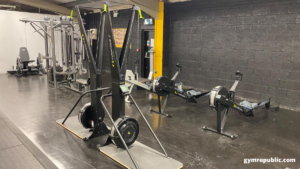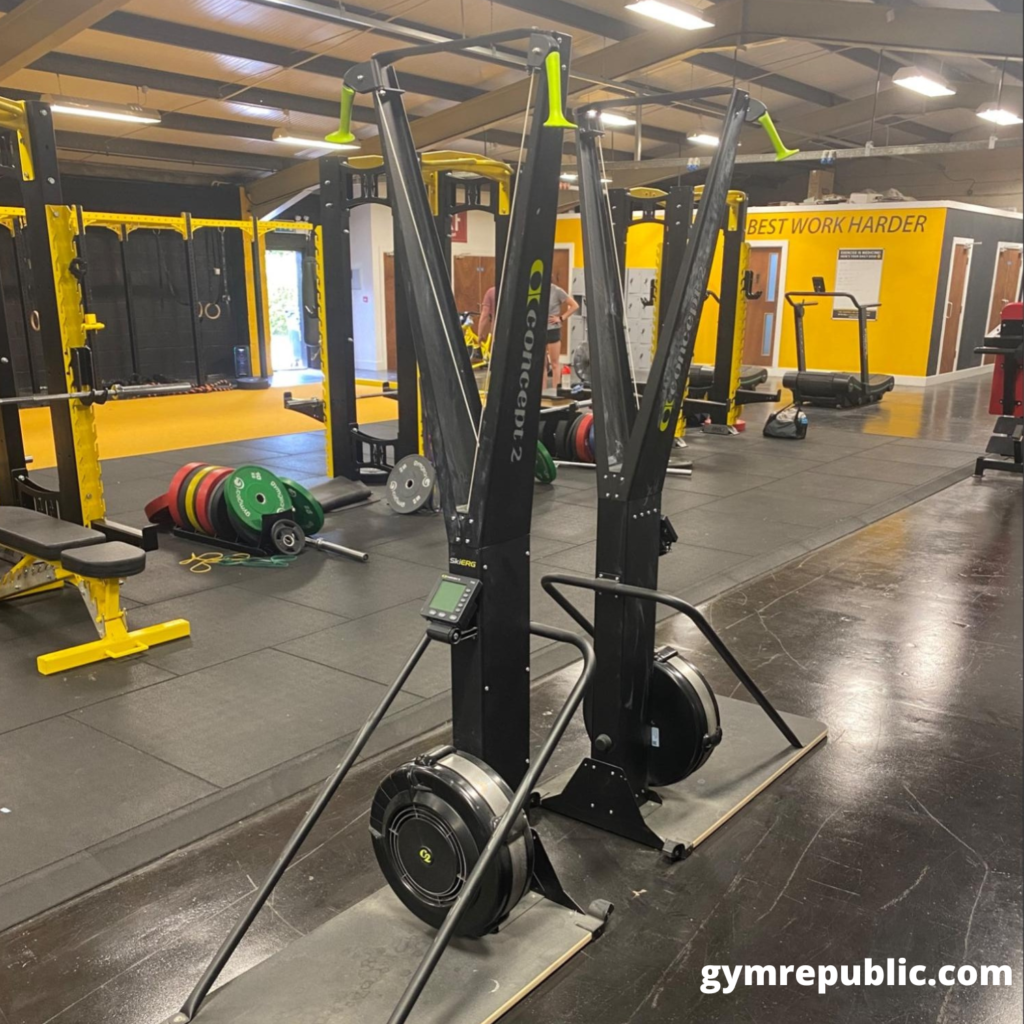


Ski Erg vs Rower - which is the best? I’m in a unique position to answer this question because I own both of them at my gym and use them every week.
They’re very similar machines in the sense that they share a lot of the technology, the same fundamental movement patterns, and the same resistances. They offer benefits to a wide range of people and for my money, rank amongst the best of the cardio machines on the market.
We’ll look at each machine in more detail, with the good and bad of both being independently assessed.
They’re both excellent workouts, but they do require different movement patterns, and that changes the intensity and the parts of the body the machines work. Here’s an overview of them both…
The rower is a more even split of upper and lower body. The lower body does most of the work, with a prominent leg drive initiating the movement, but the upper body also contributes significantly with a large pull when the leg drive has been completed. The pull relies on the lats and trapezius muscles.
The abdominals engage when the torso leans back to complete the full pull of the handles, thus making it a true full-body workout. It’s a very efficient movement and allows you to cover distance relatively quickly.
Of course, you can make the workout very high intensity with a big leg drive and a hard pull, or you can slow it down with a long, strong, pull. Use of proper rowing technique makes for a very efficient stroke, which will allow a good rower to use the machine for a long time without being exhausted.
The ski erg technique is a lot less leg-heavy. The legs simply provide a stable base, from which a high overhead reach takes hold of the handles and pulls them directly downwards. There’s an ability to use more of the body weight to pull the handles down, which helps to boost the intensity of the workout.
Directly pulling down uses the lat muscles heavily, plus you can generate a lot of force with the core. The triceps are involved in the final stages of the movement. The upper back muscles that are utilized in rowing don’t really get a look in here.
With the ski erg not being able to utilize leg power, it’s a less efficient workout than the rowing machine, but then that makes it harder on the muscles that it does use. Ski ergs tend to be more popular than rowers for the high-intensity workouts done in sports like CrossFit.

The major muscles are the latissimus dorsi that run either side of the back. They’re big, strong muscles that can generate a lot of force. There’s significant involvement of the teres major as the scapular movement is a major element of the movement.
The core is heavily involved with pulling the handles downwards. The fast, powerful pull down of the torso generates a lot of the force of the movement. The erector spinae muscles help support the spine through the action.
At the end of the rep, the triceps complete the extension of the arm at the elbows. There’s not a huge amount of arm musculature involved because the arms are relatively straight throughout the movement compared to rowing.
The full list of muscles used in the various phases of the rowing stroke can be found here. As a more general guide though, this is what happens…
In the ‘catch’ position (start of the stroke), the legs are bent fully and the arms reach forward. In the next phase (the drive), you push back hard with the legs, so you use your quads and glutes.
The pull phase uses the muscles of the back - in particular the latissimus dorsi, trapezius, rhomboids and rear deltoids.
The ‘finish’ position involves a lean back to maximize the strong length, so that will engage the abdominals and the hip flexors as well.
If you are going to be super detailed about it there are other, smaller muscles involved in the rowing stroke but their influence is actually really rather limited, so they’re not worth mentioning in here. It’s essentially a lower body push, upper body pull movement.
You can mix both machines with fantastic results - just don’t try to use them for the same job, otherwise they’ll effectively cancel each other out.
I like to use the rower for a longer duration, high-calorie burn workouts. I think the movement efficiency element of the rower, plus the fact that you can spread the workload across the whole body makes it a better choice for the longer, slower cardio workouts.
The ski erg is perfect for explosive, fast, and high-intensity interval workouts. I tend to have my personal training clients do the sprinting or high-energy output workouts on the ski erg.
It doesn’t lend itself to longer workouts as well as the rower, so you’re best off using it for faster, high burst workouts.
They’re both pretty good, but the rower is the better one in my opinion.
Weight loss is all about creating an energy deficit - you have to burn more energy than you consume. The rowing machine allows you to workout comfortably for longer, it uses more muscle mass and would be a more effective calorie burner.
You could still use the ski erg for weight loss - it’s an excellent HIIT (High Intensity Interval Training) workout machine, but for the longer, higher calorie burning workouts I’d always go with the rower as my weight loss tool.
In a word, very!
Depending on the intensity you row at, it’s not out of the question to burn up to 1000 calories per hour on the rowing machine. That’s a huge number of calories to burn, especially when you factor in the lack of recovery time and injury risk.
If you were to burn 1000 calories running, you’d have huge impact forces through your body and the recovery would take a lot longer. You could easily perform 3-5 rowing workouts per week, burning thousands of calories per week. That is very effective for weight loss.
If you were to combine 4 x 500 calorie-burning rowing workouts per week with a sensible, calorie-controlled diet you’d lose a lot of weight very quickly.
When it comes to weight loss, rowing machines are amongst the best of all fitness equipment options.
This largely depends on how you are motivated…
If you love the community aspect of training and you are motivated by lots of people around you, then both can work. You can join a ‘crew’ class in a gym and be motivated by the people around you. Crew classes are done on rowing machines.
If you attend a CrossFit facility, there’s a good chance you’ll be using ski ergs more than rowers. You are motivated by the group setting that way, pushing yourself to your limit!
If you train at home, then a machine like the Hydrow (affiliate link required) might be more motivating because you can join the online classes. If you need the classes to motivate you, a rower is definitely a better option than the ski erg, because to my knowledge no ski erg classes exist.
If you don’t need an online class, but you are motivated by comparing your data to others around the world, then Concept2 row ergs have a huge global following and online community where you can track your progress relative to others around the world. That can be hugely motivating for some people!
Ultimately the answer to this question depends on how you are motivated. Generally speaking though, there’s more data, more tracking, more classes and more community around the rower than the ski erg.

Weight loss is about creating a calorie deficit, so you can approach this in two ways…
For most people, the former is the best option. It takes less time to recover from easier workouts because they’re not as physically draining. The per-workout time is reduced, meaning you don’t have to sacrifice as much time. Finally, it’s mentally easier; 30-45 minutes is more achievable than 2 hours!
That being said, you’ll still have to work hard. For my weight loss clients I want them to be aiming to burn 2000 calories or so per week through exercise alone, and the rest of their calorie deficit (which varies depending on their size, weight loss goals etc) are made up by calorie restricted eating.
For most people, 300-500 calories will be burned in 30-45 minutes of rowing. Aim for 4 sessions per week of this length and you’ll help yourself lose weight.
Horizontally, the rower takes up more space. Its dimensions are as follows…
It can be stored upright, which is helpful in a tight space. Just bear in mind you’ll need a ceiling that’s a minimum of 100 inches (250cm) tall!
Vertically, the ski erg is bigger. You also have to factor in the stand size. If you don’t use the support stand, you’ll have to wall-mount it, which reduces your positional flexibility significantly - you won’t be able to move it around if it’s bolted to the wall!
The different dimensions are as follows…
Wall Mounted:
Mounted on Floor Stand: 23.5 in x 50 in x 85 in (60 cm x 127 cm x 216 cm)
If you want something that is more community based and versatile, go with the rower. It’s better for long-distance, long-duration work. It’s also suitable for short-duration, high-intensity work too.
The data, the classes, and the online community mean that it’s better for the home user as well.
If you aren’t bothered about that and instead are looking for a great HIIT exercise machine, go with the ski erg. Whilst it’s probably not as well suited for long-distance work, nor is it much of a leg workout, it’s an excellent HIIT tool.